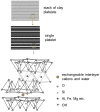Review on the Processing and Properties of Polymer Nanocomposites and Nanocoatings and Their Applications in the Packaging, Automotive and Solar Energy Fields
- PMID: 28362331
- PMCID: PMC5408166
- DOI: 10.3390/nano7040074
Review on the Processing and Properties of Polymer Nanocomposites and Nanocoatings and Their Applications in the Packaging, Automotive and Solar Energy Fields
Abstract
For the last decades, nanocomposites materials have been widely studied in the scientific literature as they provide substantial properties enhancements, even at low nanoparticles content. Their performance depends on a number of parameters but the nanoparticles dispersion and distribution state remains the key challenge in order to obtain the full nanocomposites' potential in terms of, e.g., flame retardance, mechanical, barrier and thermal properties, etc., that would allow extending their use in the industry. While the amount of existing research and indeed review papers regarding the formulation of nanocomposites is already significant, after listing the most common applications, this review focuses more in-depth on the properties and materials of relevance in three target sectors: packaging, solar energy and automotive. In terms of advances in the processing of nanocomposites, this review discusses various enhancement technologies such as the use of ultrasounds for in-process nanoparticles dispersion. In the case of nanocoatings, it describes the different conventionally used processes as well as nanoparticles deposition by electro-hydrodynamic processing. All in all, this review gives the basics both in terms of composition and of processing aspects to reach optimal properties for using nanocomposites in the selected applications. As an outlook, up-to-date nanosafety issues are discussed.
Keywords: barrier improvement; electrospraying; light-weight materials; nanocomposite; nanodeposit; self-cleaning surfaces.
Conflict of interest statement
The authors declare no conflict of interest.
Figures








References
-
- International Organization for Standardization (ISO) Part 4: Nanostructured Materials. International Organization for Standardization; Geneva, Switzerland: 2011. Nanotechnologies—Vocabulary.
-
- Schmid M., Benz A., Stinga C., Samain D., Zeyer K.P. Fundamental investigations regarding barrier properties of grafted PVOH layers. Int. J. Polym. Sci. 2012;2012:637837. doi: 10.1155/2012/637837. - DOI
-
- Schmid M., Sängerlaub S., Miesbauer O., Jost V., Werthan J., Stinga C., Samain D., Stramm C., Noller K., Müller K. Water repellence and oxygen and water vapor barrier of pvoh-coated substrates before and after surface esterification. Polymers. 2014;6:2764–2783. doi: 10.3390/polym6112764. - DOI
-
- Hosokawa M., Nogi K., Naito M., Yokoyama T. Nanoparticle Technology Handbook. Elsevier Science; Oxford, UK: 2007.
-
- International Organization for Standardization (ISO) Part 2: Nano-Objects. International Organization for Standardization; Geneva, Switzerland: 2015. Nanotechnologies—Vocabulary.
Publication types
LinkOut - more resources
Full Text Sources
Other Literature Sources
Research Materials

